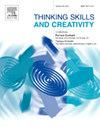How to set up a formal Design Thinking course that works? A practical guide for higher education settings
IF 3.7
2区 教育学
Q1 Social Sciences
引用次数: 0
Abstract
Design Thinking has been gaining ground in different disciplines at higher education institutions worldwide as it is seen as a way to develop 21st century student skills; especially creativity, problem solving and teamwork. It provides a student-centred approach linked to constructivist learning theory. However, the available literature fails to shed light on how to successfully facilitate Design Thinking for non-designers, not only to learn the methodology but also to improve such 21st century skills. This paper shares a thorough guide to assist any educator or educational manager interested in implementing an evidence-based intervention that has proven to teach Design Thinking while also improving key skills such as problem solving, creativity and teamwork. We provide full disclosure of a semester-wide intervention of a university level course for first-year undergraduate students enrolled in different programs. We present results about the course effectiveness from the point of view of students, facilitators and sponsors. Key features of this course design include: a stepwise approach to learn the Design Thinking methodology, class sessions that follow a hands-on approach with space for instant feedback, exposition to real-life problems and teamwork, and a classroom environment pertinent for teaching Design Thinking. This work not only provides theoretical and practical implications but also serves as a guiding framework for effective design facilitation, from non-designer facilitators to non-designer students, with potential to be applied, adjusted, or even rebuilt for diverse subject disciplines and specific contexts.
如何建立一个正式的设计思维课程?高等教育设置的实用指南
设计思维已经在世界各地的高等教育机构的不同学科中获得了一席之地,因为它被视为培养21世纪学生技能的一种方式;尤其是创造力、解决问题的能力和团队合作能力。它提供了一种与建构主义学习理论相联系的以学生为中心的方法。然而,现有的文献未能阐明如何成功地促进非设计师的设计思维,不仅要学习方法论,还要提高这种21世纪的技能。本文分享了一个全面的指南,以帮助任何有兴趣实施基于证据的干预的教育者或教育管理者,这种干预已被证明可以教授设计思维,同时还可以提高解决问题、创造力和团队合作等关键技能。我们为参加不同课程的一年级本科生提供了一学期大学水平课程的全面干预。我们从学生、主持人和赞助者的角度来展示课程有效性的结果。本课程设计的主要特点包括:采用循序渐进的方法学习设计思维方法,课堂教学遵循实践方法,为即时反馈提供空间,对现实问题的阐述和团队合作,以及与教授设计思维相关的课堂环境。这项工作不仅提供了理论和实践意义,而且为从非设计师促进者到非设计师学生的有效设计促进提供了指导框架,具有应用、调整甚至重建不同学科和特定环境的潜力。
本文章由计算机程序翻译,如有差异,请以英文原文为准。
求助全文
约1分钟内获得全文
求助全文
来源期刊

Thinking Skills and Creativity
EDUCATION & EDUCATIONAL RESEARCH-
CiteScore
6.40
自引率
16.20%
发文量
172
审稿时长
76 days
期刊介绍:
Thinking Skills and Creativity is a new journal providing a peer-reviewed forum for communication and debate for the community of researchers interested in teaching for thinking and creativity. Papers may represent a variety of theoretical perspectives and methodological approaches and may relate to any age level in a diversity of settings: formal and informal, education and work-based.
 求助内容:
求助内容: 应助结果提醒方式:
应助结果提醒方式:


